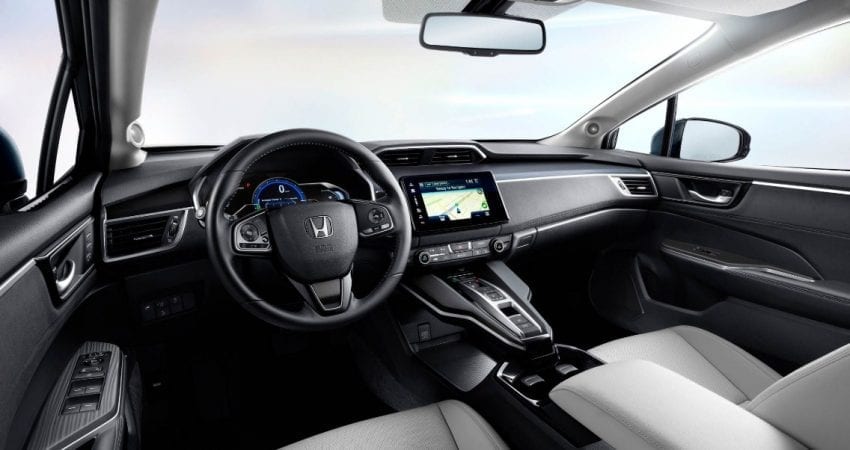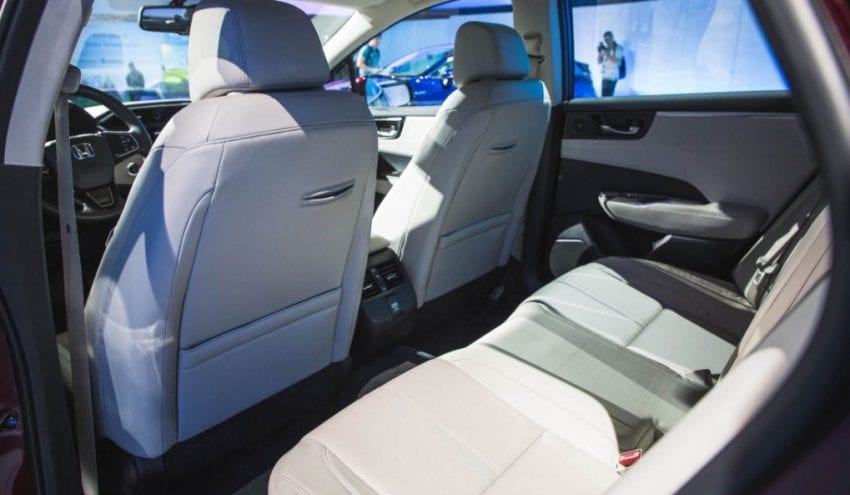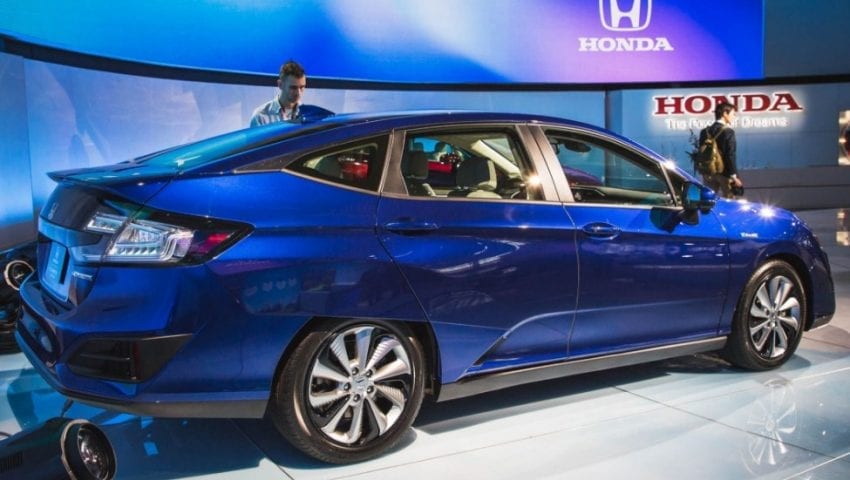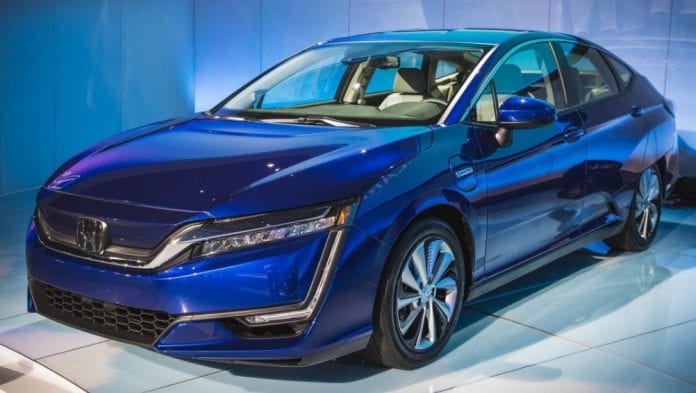Some of you probably remember the Clarity nameplate that Honda introduced back in 2008 with the FCX Clarity which was a mid-size, five-passenger, four-door sedan equipped with a hydrogen-powered electric motor. That vehicle was the very first hydrogen fuel cell passenger car ever offered for the general public, and its production was ended in 2014 with only a handful of units sold. The Japanese brand decided to give it another go and what you see here is the reintroduction of the nameplate that was introduced in December of 2016.
Honda kept everything pretty much the same – it is still a four-door sedan for five passengers, body style has some new cuts and details, while under the hood there is a hydrogen fuel cell powertrain. This time the H2 model is joined by two other powertrains in the lineup that include an all-electric and plug-in hybrid variant, both of which were unveiled earlier this year at the New York International Auto Show. With these three versions, the company expects that they will boost the interest of the broader public and by doing that increase the overall sale numbers.
Their current goal is 75.000 units over the course of the next four years, representing a five-fold increase in electric vehicle sales overall. Jeff Conrad, senior vice president of American Honda Motor Co., Inc stated that “The Honda Clarity is aimed at accelerating the deployment of advanced electrified powertrain technology and bringing electrified vehicles further into the mainstream.” He continued by adding “The Clarity series also heralds the advancement of our Honda Electrification Initiative, representing our investment in the full spectrum of electric-vehicle technologies.”
To make the Clarity a little more up-to-date it received a unique, standout exterior style that’s hard to miss. The motive that stretches throughout the entire design is functionality in nature, and that functionality is achieved with body panels that lower the overall drag coefficient and maximizing the miles possible from each of the models’ power sources. The design is definitely “unique” but it should be well received especially when we know there is something like the Toyota Prius driving around the streets.
Exterior

The car’s stance is nice, it’s pretty close to the ground which is supposed to help it minimize the amount of air flowing underneath it while looking a bit aggressive as well. At its front, it has a wide chrome strip that rises into slim, squared-off headlights. It also boasts with thin L-shaped daytime running lights that branch out from the outside edges of the headlight housings.
The profile of this model looks nice with the sloping roofline that lends the sedan an almost hatchback-like appearance. It kinda reminds us of a Civic for that matter. As you can see from the pictures, there is one unique piece on it and its the apron element covers that are at the top edge of the rear wheels. These are there in order to help keep air from getting mixed up under the fender and smoothing out some of the drag.
At the back of the car, you can see a nice round tail that completes this unique design. The rear deck is somewhat flattened, while the C-shaped taillights wrap around into the rear fenders, and again some of the creases and lines strongly reminiscent those on the latest Honda Civic.
Besides the three new powertrains, there isn’t that much that separates the old one from the new one. Except for the addition of unique badging and wheel designs. Honda also mentioned that they reshaped the front end, headlights, and taillights, but those changes are too minor to make a lot of difference. New wheels come with 18-inch diameter, and all three models have their own “special hero color,” where if you chose the Clarity Fuel Cell you get to make a choice between the Bordeaux Red Metallic, White Orchid Pearl, and Crystal Black Pearl paint. As far as paint-jobs for the all-electric and plug-in hybrid variants are considered, we found nothing that even slightly hints at them, but with time they will be revealed.
Honda Clarity 2018 Interior

The interior of the 2018 Honda Clarity is a bit more conservative than its exterior is. It sends a spacey vibe when you sit in it for the first time. The central tunnel in particular really got the sci-fi treatment, and it is emphasized even more thanks to a geometric, angular cut, and a center stripe of buttons. Behind the three-spoke, multifunction steering wheel neatly sitting are digital gauges, and the central dash is equipped with a touchscreen display which is showing info like navigation and various other infotainment details.
According to Honda all of the materials used are Eco-friendly, but they still managed to include some sleek elements and high-end stuff that you normally expect from a vehicle of this price range, and by that, we mean wood trim, leatherette upholstery, and brushed metal surrounds. The Japanese carmaker says that thanks to the three powertrain options Clarity in cabin offer to passengers will be graced with a low level of interior ambient noise and a reduction in vibration and harshness. If you opt for the Clarity Fuel Cell model passengers in the back will have a lot more room thanks to the more compact powertrain.

The infotainment segment is regulated by the company’s Display Audio platform, which offers expanded smartphone support via Apple CarPlay and Android Auto, including smartphone-like operations such as tap, pinch, and swipe commands. The layout of the 2018 Clarity cabin is asymmetric in design, complemented by curvy, silver trim pieces included on the three-spoke steering wheel and door panels. There is also some Piano-black plastic which is used for some of the surrounds.
Powertrain
As we already mentioned the 2018 Honda Clarity offers three different options and we will start with the plug-in hybrid model first. This version will host a 1.5 L Atkinson cycle four-cylinder that pairs with an electric motor and 17 kWh battery pack where the internal combustion 1.5 L unit will act as a direct power source, or it can generate electricity to recharge the battery pack. The output from this powertrain is rated at 181 HP and 232 lb-ft of torque, while the battery pack can get topped off in around 2.5 hours when plugged into a 240-volt power source.
With a full battery and a full tank of gas, 2018 Clarity according to Honda can travel up to 330 miles, while the all-electric range comes in at 42 miles, which by Honda claims is the “longest of any mid-size plug-in hybrid.” There are also four different driving modes – Normal, Econ, Sport, and HV mode, which preserves the current charge of the battery to save electric range for a later time. With EPA estimates returns at a rated 105 MPGe combined, Honda is already boasting that this is “top of its class.”
Honda Clarity Electric will exclusively be powered by an electric motor that produces 120 kilowatts or 161 HP, and 221 pound-feet of torque. What actually gives power to the motor is a battery pack rated at 25.5 kWh, which when plugged into a 240-volt power source fully charges the battery in roughly 3 hours. The Clarity Electric also gets the option for DC quick charging, and with this setup, it will reach 80% charge in 30 minutes. Here you will have only three driving modes – Normal, Econ, and Sport which are there to help you achieve that 111 MPGe combined rating. The only place the Clarity falls behind is the range per charge as it offers less-than-impressive 80 miles between plug-ins.
Clarity Fuel Cell is the third option, and it got a number of powertrain improvements and upgrades compared to the previous model year of the hydrogen-powered Clarity. 2018 MY now has a more compact fuel cell stack and improved power density by 66%. According to Honda the fuel cell and hydrogen powertrain are now roughly equivalent in dimensions to a modern V6 internal combustion engine, offering greater cabin space as a result. The range of the Clarity Fuel Cell with a full hydrogen tank is 366 miles which is, at least according to Honda, highest EPA-rated driving range of a zero-emission vehicle on the U.S. market. One more thing to know is that the EPA gives the Clarity Fuel Cell an estimated fuel economy of 68 MPGe combined.
Safety
Since the Clarity is all about cutting-edge technology, the 2018 model year definitely couldn’t pass the opportunity to utilize the latest Honda Sensing safety and driver-assist features. That means you will be graced with Adaptive Cruise Control, Collision Mitigation automatic braking, lane-keep assist, Road Departure Mitigation, lane-change assist, blind-spot monitor, Cross Traffic Monitor, automatic high beam headlights, and more. What is even better news is that all of this is included as standard equipment. As far as crash testing ratings are considered we regret to inform you that neither the National Highway Traffic Safety Administration (NHTSA) nor the Insurance Institute for Highway Safety have posted any ratings for the Clarity. Well, not yet of course.

2018 Honda Clarity Price
The Japanese brand will produce the Clarity in the US, and the great news is that the Plug-in Hybrid and Electric variants will be offered in dealerships later in 2017. Official pricing is unknown and has yet to be announced, but we expect figures around the $35,000 mark. Sales for the Plug-in model will be in all 50 states while the Electric model will be offered with exclusive lease programs in California and Oregon. If you opt for the third variant – the Fuel Cell model than Honda will offer it for $369 a month for 36 months, with $2,868 due at signing. The lease will include a 20.000-mile annual allowance, as much as $15,000 in hydrogen fuel, 21 days of Avis Luxury Rental inside California, roadside assistance, and single occupant HOV lane access. Further incentives include a $5,000 rebate for California residents.
What it all adds up to?
Well, the intention of Honda here is obvious – bet everything on the green, electrified transportation and offer any and all possible powertrains under a single nameplate. This was to some extent confirmed by Steve Center, vice president of the Connected and Environmental business Development Office at American Honda who stated: “Electrification is the future of mobility and the future of Honda, and it all starts now with this new Clarity series.” He continued by adding “This shared “3-in-1″ platform strategy will enable Honda to respond to infrastructure and market developments, provide customers nationwide with an ultra-low carbon vehicle that meets their lifestyle needs, and takes Honda toward higher volume sales of advanced powertrain products that will help reduce CO2 emissions.”









